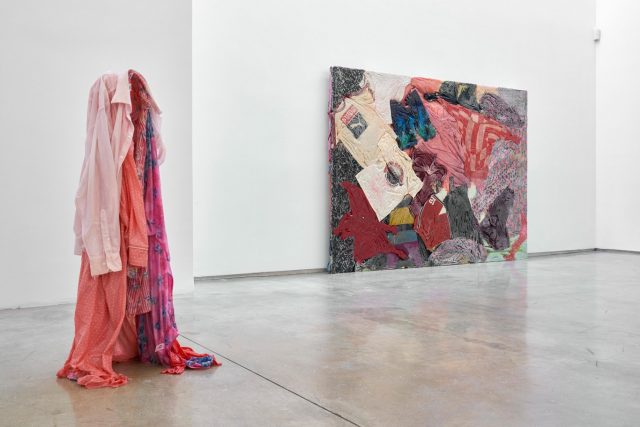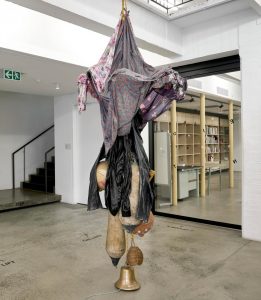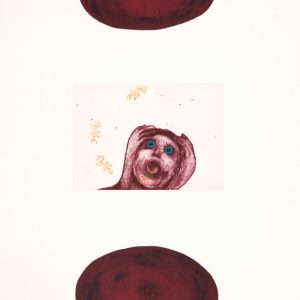A4 Arts Foundation
06.02 - 30.04.2020
On a window seat, left in haphazard arrangement: a dried piece of kelp, a t-shirt and an airline luggage ticket, marked CPT – priority heavy. The accompanying list of materials, which appears in the exhibition handout, extends to include the suggestively vague medium of detritus. It may or may not refer to the beach sand that surrounds the arrangement, or to the rectangle of clear, pink plastic sheeting on the floor beside it. Perhaps it refers to the noise from the street below, or to the view of the East City just beyond the glass – to the detritus of urban sounds and scenes. Or perhaps it has become a collective noun for all these things taken together; sand, police siren, t-shirt. The flotsam and jetsam of daily life that momentarily collide in this place, at this window.
Kevin Beasley’s ‘without a clear discernible image’ is an exhibition of works made during the New York-based artist’s one-month residency at the A4 Arts Foundation in Cape Town. For the duration of his January stay, the first-floor gallery was temporarily reimagined as studio, before it reverted to the austere space of gallery for the opening of his show. Few traces of the studio are left; none of its attendant chaos nor the thick fumes of curing resin. Only the finished works remain (the artist too is absent, having returned to his Harlem studio).
Fragments, quotations, samples – these are the parts that make the whole. A basketball, a moon boot, dried flowers, a fishing net, a skirt. Beasley is preoccupied, above all, with provenance, with the inheritance of found objects, scenes and sounds. Caught between the legible and the obscure, Beasley’s work blurs the divide between objecthood and personhood, gestures always to the trace of the body, ask what these fragments might suggest about lives and living.
Left untitled, many of Beasley’s sculptural works depend on their respective lists of materials to transmit meaning. There is the ubiquitous ‘housedress’ – which is any dress in Beasley work – a word that has about it a distinct Southern accent. Much like his do-rags and Jordans, his material motifs gesture to African American cultural signifiers. He is, above all, concerned with cotton, with the history of cotton and everything it has come to represent as a symbol of labour and oppression. Working with the social fabric of clothing, Beasley explores not only the past but aspirations for the future as reflected in society’s objects. For this exhibition, Beasley worked with ‘Aid-to-trade’ garments, with donated American clothing that has found its way into the South African informal economy, redirected from its charitable intentions to profitable ones, and now soaked through with resin and art’s aura.
Beasley works on his resin sculptures only as long as time allows before the polymer begins to harden, the materiality of the resin dictating the boundary between process and sculpture; when a moving, changeable thing becomes static object. “It’s a way for me to process and crystallize the way I am thinking about these objects culturally, socially, and politically,” Beasley said of his resin works in an interview for Mousse Magazine. “To form them, mould them, shape them, and recognize time. It is a way of making sculpture that allows me to pack what I’m thinking about into the work. This might happen literally, or it might be a matter of what I’m thinking about—imbuing a form with a sense of purpose just by allowing my concerns into the studio.” In this way, the artist’s body is inscribed in each sculpture, the forms worked as the resin cures. But there are other bodies too, absent bodies implied by the works’ very materials; those bodies who once wore the donated clothes, and those who were intended to wear them before they were redirected to the studio.
Beasley’s clothing assemblages share the gallery floor with three fabricated traffic barricades made in plywood. Arranged under gallery strip lights, removed from the street, they appear as monolithic, modernist sculptures yet continue to carry all that their function suggests as barrier and boundary. They set themselves apart from the clothing works – which are largely bright, improvised and process-driven – with their studied exactitude. Their minimalism finds reflection in a series of nine works on paper, which are uniformly grey in colour and content. Unknown to the passing eye, however, these works are not mere surface, but the remains of process. Each work on paper was first a working list of objects collected or seen, written in large print and tacked to the studio wall. Later obscured by the artist as he worked, their previous, pragmatic role is recalled only in their titles.
The artist extends his engagements with cultural detritus – its leftovers and hand-me-downs – to include incidental sounds. Finding the object and the aural to be analogous, Beasley’s practice moves fluently between these two forms. “Sound for me,” Beasley said in a 2013 interview, “is just as physical, tactile and experiential as any other material.” In the video room, in complete darkness, a four-channel audio installation plays to the unseeing listener. The work, which shares a title with the exhibition, is a compilation of field recordings taken in and around the city: rush-hour traffic, music playing from a shop, the beeping of a pedestrian crossing, passing conversations. Beasley plays back these audio fragments with deep sub-frequencies, which make the recordings resonate not only in the space but in the listening body. In this way, sound is experienced not only audibly but somatically. By re-presenting the most commonplace sounds, he makes them new, invites the listener to hear with a careful attention reserved for the unknown.
A single photograph on the ground floor shows a pair of jeans hung over the dark green Company’s Garden fence to dry. It is a work easily overlooked, yet it conceptually marks the visitors’ movement from the familiar to the foreign, the inner-city street to the first floor of the exhibition. Titled Draped, this image counts itself one of only a handful of photographs, which – though more conventional in medium – continue the artist’s oblique engagement with his subject. Evoking the Simon’s Town site of forced removal under the Group Areas Act, four photographs of fynbos, taken up close, are collected under the title Luyolo. They are among the few images weighted in place, given a name, a location. These photographs are not landscapes but notes on the landscape; details rather than scenes. And again, absent bodies are evoked, just as with Beasley’s clothing sculptures, which appear as a gathering of lost figures.
Other photographs exhibited: a view of the Twelve Apostles, Hout Bay seen from Chapman’s Peak, the word ROBOT written on the road at an intersection. With these, the artist acknowledges his position, nods to his experience as outsider, as tourist. But his is not a distanced engagement with the city. As much as Cape Town is present in Beasley’s show, on leaving the exhibition, one finds, conversely, his work present in the city. The barricades of a roadblock, the sound of passing cars, a coat left hanging on a signpost. With material confidence and apparent curiosity, ‘without a clear discernible image’ offers a sensitive and complex engagement with urban debris as artefact. Taken together, all the works in this exhibition, all these fragments from a strange city – photographs, sculptures, sounds – offer a portrait of a place, of this place; its image unclear, indiscernible but familiar.











